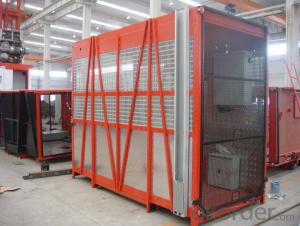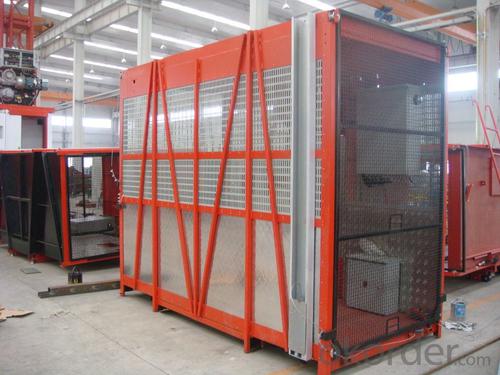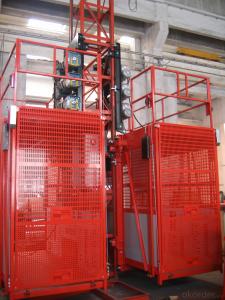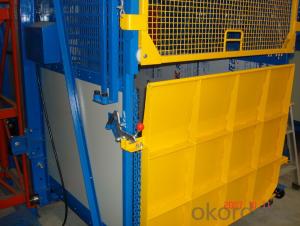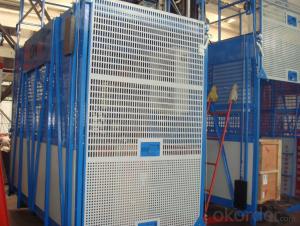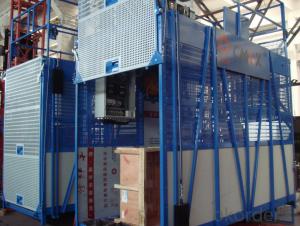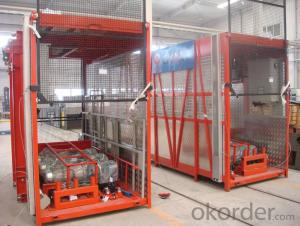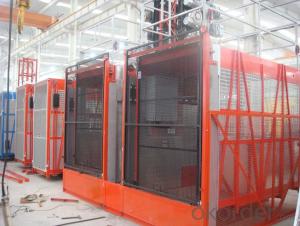construction hoist / builder's hoist/building hoist/SC200/200-6
- Loading Port:
- Tianjin
- Payment Terms:
- TT OR LC
- Min Order Qty:
- 1 unit
- Supply Capability:
- 100 unit/month
OKorder Service Pledge
Quality Product, Order Online Tracking, Timely Delivery
OKorder Financial Service
Credit Rating, Credit Services, Credit Purchasing
You Might Also Like
CMAX BUILDING HOIST SC200/200
DOUBLE CAGES
MAX LOADING CAPACITY= 2X2 T
CAGE SIZE= 3X1.5X2.5 M
MOTOR POWER= 2X3X11KW
MAST SECTION SIZE= 650X650X1508 MM
MAST SECTION & ATTACHED FRAME
TYPE OF SAFETY DEVICE: SAJ40-1.2 ADOPT HOT GALVANIZING PROCESSING
WITH OVERLOAD LIMITER & ALARM SYSTEM
- Q: This question asks if a building hoist is capable of lifting heavy objects.
- <p>Yes, a building hoist is specifically designed to lift large objects. It is a type of crane used in construction to move heavy materials and equipment to different levels of a building under construction. Building hoists can handle a significant weight, but the exact capacity depends on the specific model and its design specifications. They are essential for efficient construction processes, ensuring the safe and effective transportation of materials within the construction site.</p>
- Q: Explain the distinctions between electric and hydraulic power sources used in building hoists.
- <p>Electric hoists use electric motors to generate power, which is more environmentally friendly and requires less maintenance. They are often quieter, easier to control, and can be more energy-efficient. Hydraulic hoists, on the other hand, rely on fluid pressure to generate power. They can provide greater lifting capacity and are often used in heavy-duty applications. Hydraulic systems can be more complex to maintain and repair, and they may not be as energy-efficient as electric hoists. However, they offer smooth and controlled lifting, which is beneficial in certain construction scenarios.</p>
- Q: This question asks about the measures taken to guarantee the safety and reliability of lifting equipment prior to its use in construction.
- <p>To ensure that lifting equipment is safe and reliable before using it in construction work, several key steps must be taken. Firstly, regular inspections and maintenance are crucial to identify any potential issues or wear and tear. Secondly, all equipment should be thoroughly tested and certified by qualified personnel to meet safety standards. Thirdly, proper training for operators is essential to ensure they understand how to use the equipment safely. Additionally, having a comprehensive safety plan in place, including emergency procedures, can help prevent accidents. Lastly, using equipment from reputable manufacturers and ensuring all components are in good working order are also vital for maintaining safety and reliability.</p>
- Q: Why is the construction elevator open on one side and the other on the other
- Open the door, commonly known as the feed door, usually open up, and add weights to both sides. Only if the construction ladder stops at the bottom. If the door is double open, the room must be left with half a door (> 1.3 m) to open the door completely. If it is a single open door that opens up, you can save space in the cage. Double door, namely, two doors, either up or down, the two doors balance weight. It usually arrives on the required floor. There is enough room for double doors.
- Q: Is it possible to integrate a single-rope lifting mechanism into an electric-hydraulic lifting system?
- <p>Yes, a single-rope lifting system can be used in an electric-hydraulic lifting system. The electric-hydraulic system provides the power to lift and lower the load, while the single-rope system manages the vertical movement of the load. This combination allows for precise control and can be advantageous in applications requiring both the lifting capacity of hydraulics and the simplicity of a single-rope system. However, the design must ensure compatibility between the mechanical and hydraulic components to function effectively and safely.</p>
- Q: Is it possible to utilize a building hoist for the purpose of moving materials up and down in a warehouse setting?
- <p>Yes, a building hoist can be used to lift and lower materials in warehouses. These hoists are designed for vertical transportation of goods and are particularly useful in multi-story warehouses where space is limited. They are capable of handling heavy loads and can be operated manually or with electric power, making them efficient for moving materials between different levels of a warehouse. However, safety measures and proper maintenance are crucial to ensure the secure and effective operation of the hoist.</p>
- Q: Is it possible to replace an electric control panel with a manual lever in a lifting system?
- <p>While it is theoretically possible to use a manual lever as a substitute for an electric control panel in a lifting system, it is not advisable. Manual levers lack the precision, safety features, and control capabilities of electric control panels. They also cannot provide the same level of feedback or automation. Electric control panels are designed to ensure safe and efficient operation, with features like emergency stop buttons, overload protection, and remote monitoring. Manual levers can pose safety risks and may not meet the operational requirements of modern lifting systems.</p>
- Q: Is it possible to utilize a manual building hoist for the purpose of lifting heavy objects?
- <p>Yes, a manual building hoist can be used for lifting heavy objects. These hoists are designed to handle significant weights and are commonly used in construction for moving materials and equipment to various heights. They are operated manually, often with a hand crank or lever, and are equipped with safety features to prevent accidents. However, it's crucial to ensure that the hoist is rated for the weight of the objects being lifted and that all safety protocols are followed to avoid any accidents.</p>
- Q: Is it possible to replace a lifting rope in a construction hoist with a regular rope?
- <p>No, a regular rope should not be used as a substitute for a lifting rope in a building hoist. Lifting ropes are specifically designed for heavy-duty lifting and have safety standards to ensure they can withstand the weight and stress. Regular ropes lack these safety features and can break under heavy loads, leading to accidents. Always use the appropriate lifting equipment as specified by safety regulations and the manufacturer's guidelines.</p>
- Q: This question asks if building hoists can be utilized for extended periods of time in construction projects.
- <p>Building hoists are generally designed for temporary use in construction projects, facilitating the movement of materials and personnel. They are not intended for long-term operations. Their design and safety features cater to the specific needs of construction phases, which are temporary by nature. For permanent installations or long-term material handling, other types of elevators or lifts are more suitable. It is crucial to adhere to the manufacturer's guidelines and local regulations regarding the use and duration of operation for building hoists to ensure safety and compliance.</p>
Send your message to us
construction hoist / builder's hoist/building hoist/SC200/200-6
- Loading Port:
- Tianjin
- Payment Terms:
- TT OR LC
- Min Order Qty:
- 1 unit
- Supply Capability:
- 100 unit/month
OKorder Service Pledge
Quality Product, Order Online Tracking, Timely Delivery
OKorder Financial Service
Credit Rating, Credit Services, Credit Purchasing
Similar products
Hot products
Hot Searches
Related keywords
